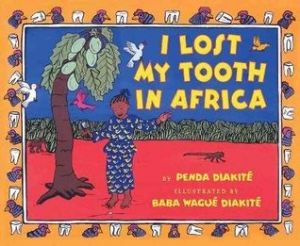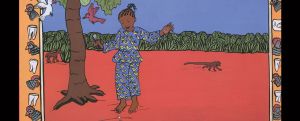I Lost My Tooth In Africa
I Lost My Tooth In Africa was written by by Penda Diakité and illustrated by Baba Wagué Diakité. This book has 32 pages and published in January 1st 2006 by Scholastic Press. The stting of this book is in Mali, West Africa. [1]
Baba Wagué Diakité was born in 1961 in Mali, West Africa. He was named as "Wagué," or "Man of Trust," after his grandfather. "I grew up in a storytelling family," Diakité remembers. "Even after my Western education in a French school, my basic understanding of life is still from this traditional education of mankind that my grandparents taught me...Without stories, there is no art." Though always artistically inclined, he didn't begin the ceramic work for which he is known until after he moved to the U.S. in 1985. Diakité's work has been in shows in New York, California, Texas, and Oregon. His first picture book, a retelling of one of his grandmother's fables called The Hunterman and the Crocodile, was named a Coretta Scott King Honor Book. [2]
Summary
More than anything, Amina wants to lose her loose tooth while visiting her family in Mali, West Africa. Only then can she put it under a gourd for the African tooth fairy, who will exchange it for two chickens! Happily this happens, and even better, the chickens lay eggs. But will the eggs hatch before it's time to return home to America? In this fresh, spontaneous story that is infused with close family warmth, Penda June Diakite joins forces with her award-winning author/artist father to give a charming peek at everyday life in Mali. [3]
Pros
There is unquestionable early elementary appeal in any story about losing a tooth; the child voice and cross-cultural setting give this tale even more liveliness. Amina's youthful descriptions of her African family yield a rich sense of familial devotion and love; all of life centers on the courtyard, the communal meals, the countless aunties and uncles. Elementally speaking, this is a universal tale of a young girl with a loose tooth and a big family, and it is this universality that allows it to overcome the tendency for memoirs to be personally significant only to the author. Each ceramic-tile illustration, framed by a patterned border, is dense with images from the tale; the illustrations exude happiness and togetherness, and the thick paint echoes the lushness of the jungle setting. This could partner with Beeler's Throw Your Tooth on the Roof for a look at global tooth-losing rituals or it could be enjoyed on its own; young listeners will appreciate this on many levels, from the identification with losing a tooth to the kid-centered descriptions of day-to-day life, from the marvel of raising chickens to the sprinkling of information about the family and village. Notes from the author and illustrator are included, as is a glossary and a basic recipe. [4]
Hope Chasteen gave the reason why she only gave this book four stars. It because this book can be considered a multicultural book. It is about a young girl born in America, but her family is from Africa. So, her parents takes her on a trip to see her other family in Africa. She ends up loosing a tooth while she is visiting her family. The little girl is so excited to have lost it in Africa, because she was told that the tooth fairy in Africa gives children chickens instead of money. She had to place her tooth inside a chicken coop to receive her chicken. She waited and waited and finally finds a hatched egg (baby chicken of her own) inside of the coop. The trip went on, and it was time to leave. So, she became sad to leave her chicken. Her uncle said he would keep it safe for her in Africa until she decides to come back to visit. I gave it four stars, because the pictures were well illustrated and it exposed children to a part of the African culture. But, Toby, the other reader, had different point of view, he gave this book five stars because it is the best multicultural books, children can identify with a universal experience, such as losing a tooth, and then see how another culture has made that experience unique. The fact that this story is a true story, written when the author was 8 years old and visiting her father’s homeland, only makes the story more appealing. The illustrations are gorgeous, beginning with the adinkra print end papers, continuing throughout with borders that highlight the subject of each painting: moon and stars at night, roosters & teeth in the daytime, black and white feathers interspersed with eggs when the much-anticipated gift from the Tooth Fairy is a chicken and a rooster. The illustrator’s note pulls it all together: “There is a proverb from Mali that says, ‘Raising a child is like planting a tree. When it is tended well, you will enjoy its shade.’ This has been a great reward for him to illustrate his daughter’s book. He has always tried to teach his daughters about his culture in which storytelling is a true way of learning. [1]
Kirkus was reviewed this book too, the reviewed was written on their site. They wrote that Penda, the author, and Amina, the subject of her older sister’s book, are the children of the inventive Malian author/illustrator who has shared his culture through retellings of traditional folktales and creative ceramic-tile illustrations with distinctive borders. Diakité includes a recipe for Malian onion sauce, mentioned in the text, a glossary and a goodnight song in Bambara, one of the languages used in Mali. The young author’s descriptions offer an amusing introduction to one African country, and an excellent way to encourage children to start writing their own family stories. [5] Publisher Weekly also taking part gave the reviewed for this book, they mentioned that with often whimsical touches, Baba Wagué Diakité illustrates a vibrant life among banana palms, birds and brightly dressed relatives and friends. Patterned borders surround each illustration, created on a ceramic tile (e.g., feathers and eggs decorate the scene of Amina's new hen laying eggs; even loose teeth come into play). Young readers may well be intrigued by how universal a milestone it is to lose a tooth, while learning the unique lifestyle of this warm and welcoming West African family. [6]
References
- ↑ Jump up to: 1.0 1.1 I Lost My Tooth In Africa.
- ↑ I Lost My Tooth in Africa. Retrieved February 9th, 2021
- ↑ I Lost My Tooth in Africa. Retrieved February 9th, 2021
- ↑ I Lost My Tooth in Africa (review) by Heather Morrison. Retrieved February 9th, 2021
- ↑ I Lost My Tooth In Africa. Retrieved February 9th, 2021
- ↑ I Lost My Tooth in Africa. Retrieved February 9th, 2021

